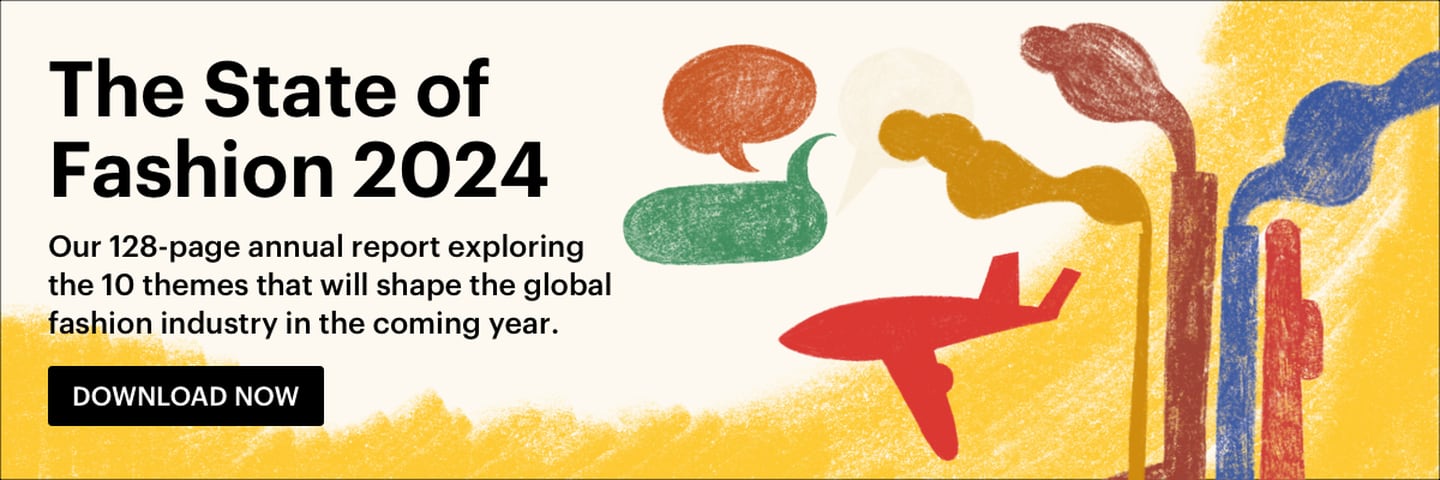
In June 2023, the United Nations published a report with a radical message for fashion brands: stop pushing overconsumption.
“The Sustainable Fashion Communication Playbook” published by the United Nations Environment Programme and UN-backed Fashion Industry Charter for Climate Action took aim at the core of fashion’s business, examining the role marketing plays in driving the cycle of overproduction and overconsumption that underpins the industry’s environmental impact.
It’s an issue signatories to the UN Fashion Charter, who include many of the world’s biggest brands, have pledged to tackle. But it also strikes at the heart of one of fashion’s biggest sustainability hurdles: businesses geared towards driving more consumption will always be part of the problem.
Increasingly, regulators are looking to tackle the challenge from various angles, looking at ways to make brands responsible for textile waste and incentivise designing for long life and circularity. But the role marketing plays has been overlooked, said Rachel Arthur, a sustainability strategist and sustainable fashion advocacy lead at UNEP.
That needs to change, but that doesn’t mean the end of fashion, it just means a new focus, she said.
BoF: Rachel, you spearheaded the playbook project. Why did you feel like this was the thing to focus on?
Rachel Arthur: This started on the UNEP side with a piece of work that was looking at the role of communication to help drive change and inspire action within the industry.
Typically, a piece of work like that would lead to a consumer-facing campaign on the need for greater sustainability within the fashion sector [or] more sustainable consumption. Actually, the outcome from strategy was that while that kind of work was possible and viable and could be considered necessary, there seemed to be a much more powerful lever to consider, not just looking at what consumers could do, but why consumers were consuming in the way that they were.
That comes down to primarily the brands and then the media, and the ecosystem that surrounds them. The industry is so good at creating desire. But we’re making people fall in love with something that isn’t serving us on a planetary basis. The primary message put forward is based on a linear economic model and on messages fundamentally of overconsumption.
These job functions need to be part of this conversation. Communication needs to be aligned to sustainability. The playbook basically is the “how.”
BoF: What are the key recommendations?
RA: Basically, there’s a role for marketing, there’s a role for storytelling. Brands need to make sure that everything they’re doing in sustainability is matched by what they’re putting out in the world. Within the playbook, we spell that out, with [a set of] pillars of work.
First, how do we ensure we’re not greenwashing or putting forward anything in the way of misinformation? I’d say that’s kind of table stakes. This is not new to the industry, but unpacking it is quite complex and it’s evolving fast as more policy comes in.
Then we start moving into areas that are newer, and I think typically where the communication professional has more of a forte or skill set that can be brought to the table that hasn’t existed here previously. This is where we’re looking at culture change.
We clearly call out that we need to eradicate messages of overconsumption. This is probably the heaviest area [of what we are outlining] in terms of complexity in practice. Marketers are ‘KPI’d’ on how much they can sell, so this is going against that logic.
But we really present positive solutions. We’re not trying to do away with fashion as it exists, but change the focus of it. From a marketer’s standpoint, it’s about saying, how can we put more of our effort, energy, creativity, budget towards circular solutions?
BoF: Can you outline what you mean by circular solutions?
RA: Ultimately, you’ve got to start with people buying less, but then you might look at other ways of consumption — resale, rental, keeping what you’ve got for longer, so the repair market, with the last thing on the list being recycling before you buy something that’s completely new and unsustainable. There’s a lot of room within that for exploration, creativity.
And it is important here to recognise that there isn’t one size fits all. Sustainable consumption looks different in different markets. In some markets, we know that basic needs still need to be met, so we’re not asking for reduction in consumption as a blanket global view.
[But] the third section is about ‘reimagine values,’ and this section could underpin all of it. We’re trying to inspire people to think and aspire to something different. We call [fashion marketers] ‘architects of desire,’ so how can we redirect aspiration towards sustainable lifestyles?
BoF: You’ve already alluded to the tension underlying this work: you’re essentially trying to encourage marketers to start selling something that is at odds with their current KPIs and where it’s not clear what the business model is. How does this fit with broader conversations around sustainability?
RA: It is the elephant in the room. I think most businesses along that sustainability journey now recognise that, but that doesn’t mean they’re yet willing to address it at the board level or the senior executive level. This is new, not in the sense that nobody knows about it, but it’s not yet been a true conversation. What we have been trying to do with the playbook is to say this needs to be on the table.
It’s not on the shoulders of those who work in a communication capacity, of course, but if you look at the bigger picture of what the playbook is talking about, it is addressing the system’s challenge, which is to say that we can push as hard as we possibly want with all of the evolution that is needed, but we won’t get anywhere within that if we don’t also look at volume.
BoF: When we talk about systems, regulation often comes up as a lever for change. What role should policy play?
RA: We’re seeing policy come down the line that is focused on the green claim side of things, but it is interesting starting to think about what that could look like from a sustainable consumption standpoint and what might be indeed possible within all of that.
The fourth section of the [playbook’s] principles is called ‘drive advocacy.’ It looks at a couple of lenses. Obviously, how do we push for greater education from a broad consumer-based standpoint? Within that, we talk about the internal lever that communicators can help play to help ensure that there’s accountability for change within the business. Also [they can] help play a role within the policy landscape, recognising that a lot of these businesses are incredibly powerful and that there could be an opportunity from a very competitive standpoint to advocate for wider change that facilitates sustainability in a wider sense.
BoF: How do you see the regulatory landscape at the moment?
RA: There’s so many things going on within the policy landscape, which are interesting, potentially exciting, highly complex and bewildering for a lot of the industry to get their head around.
The green claims side of things, the industry is kind of ready for it. Everybody just wants that guidance. Yes, there are going to be hurdles to actually get people on the right page, but just having black and white, ‘this is what you can and this is what you can’t do,’ it’s going to be really helpful for everybody. And it also helps level the playing field.
In a wider sense, I think we’re at an interesting juncture in terms of policymakers recognising this role of consumption as a result of unsustainable production. The waste side of things is a very interesting lever. We have to recognise in this conversation around overconsumption just how much waste there is in terms of the stuff that was [never sold].
What we also really need to see is incentives for businesses around doing ‘the right thing.’ On the one hand, that’s [encouraging the use of] sustainable preferred materials so consumption that is happening is less impactful, but also do we push for circular solutions to be more easily facilitated or incentivised?
I’m not sure that we’re seeing that play out fully as yet but I think all of those things combined — which we know is not going to happen overnight — would be incredibly beneficial.
BoF: Are things missing from the conversation, and in particular the policy conversation?
RA: This elephant in the room around production levels and volume. It’s really interesting to think about what that looks like at a policy level. While we see certain regions looking at reducing, for instance, fast fashion, I think there’s a much bigger picture that isn’t necessarily in there, which is looking at consumption behaviour, and how that’s perpetuated by an overproduction model and how we look at that holistically in terms of the way that businesses are measured on success.
Lastly, the area that we don’t include as much as we should is around the worker side. How do we ensure that garment workers are being paid a living wage or the right amount for what they’re creating. What does that look like in a world of creating less?
This interview has been edited and condensed.
This article first appeared in The State of Fashion 2024, an in-depth report on the global fashion industry, co-published by BoF and McKinsey & Company.



